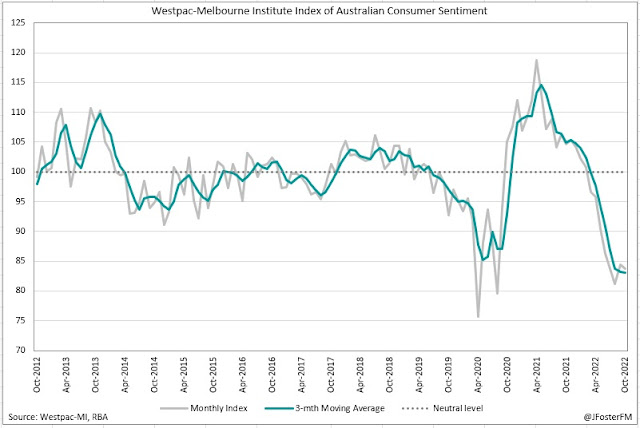Another volatile week for markets with bonds again at the epicentre of the moves. A stronger-than-expected print on US inflation has prompted yet another reassessment of the path for Fed rate hikes. In the UK, the end of the Bank of England's temporary interventions in the gilt market came to a head with PM Truss securing the resignation of Chancellor of the Exchequer Kwarteng as the government looks for a reset following its mini-Budget.
Global growth outlook downgraded
In its October World Economic Outlook, the IMF left its forecast for global growth in 2022 unchanged at 3.2% but cut its 2023 forecast to 2.7%; the downward revisions to the latter now exceed 1ppt since the April report reflecting the headwinds from the squeeze on real incomes from high inflation, the war in Ukraine and slowing growth in China due to lockdowns. The group now expects global inflation to reach a new peak of 9.5% before declining in 2023 to 4.7%. While prescribing central banks to stay the course in tackling inflation, the IMF in its Global Financial Stability Report warned of the fragility of the situation, highlighting that financial conditions could tighten in a disorderly manner posing further risks to the economic outlook.
US inflation again surprises to the upside...
September's US CPI data came in stronger than expected and was driven by the core components of the index, highlighting the broad-based nature of price pressures. Headline CPI lifted 0.4%m/m (vs 0.2% expected) easing the annual pace from 8.3% to 8.2% (vs 8.1%), while the core rate was up 0.6%m/m (vs 0.2%) elevating the year-on-year pace from 6.3% to 6.6% (vs 6.5%), a new cycle high. This was the 8th occasion in the past 12 months that annual core CPI has surprised on the upside of expectations.
Over Q3, the headline inflation rate fell by almost 1ppt from its peak of 9.1% in June, mainly reflecting declines in gasoline prices and an easing in goods inflation. However, the core rate has picked up over the period, from 5.9% to 6.6%, on the back of rising services inflation. This has come about as spending patterns have adjusted to the wider reopening of the economy after the pandemic, and from the lagged effect on rents from a very strong housing market. Going forward, goods inflation is likely to slow further because upstream price pressures faced by producers have eased, delays hampering supply chains are shortening and wholesalers are continuing to build up inventories. On the services side, leading indicators show rents are now retracing their upsurge, but this will take some time to flow into the CPI data. On the other hand, wage pressures in a tight labour market present a risk that services prices could prove to be difficult to slow.
... leaving the Fed to keep hiking rates
With high inflation persisting, this only adds weight to the central message in the FOMC's September meeting minutes: the policy pivot will not be forthcoming until rates have been hiked to a level seen by the Committee as sufficiently restrictive. The dot plot implies this is around 4.5%, still well above the current setting (3-3.25%) with a 75bps hike expected at the next meeting, though there could be some upside risk to this given that market pricing for the terminal rate is now pressing 5% off the back of the CPI report. The mindset of the Committee was made clear by the view that "a period of below-trend real GDP growth" and a softer labour market are required to turn the tide on inflation and that "...the cost of taking too little action to bring down inflation likely outweighed the cost of taking too much action".
Pessimistic Australian consumer sentiment continues
Australian consumer sentiment fell deeper into pessimistic territory, slipping a further 0.9% to an 83.7 reading on the Westpac-Melbourne Institute Index in October, well below the neutral line of 100. High inflation and the RBA's rate hiking cycle continue to weigh on sentiment. However, the RBA's downshift to a 25bps rate hike earlier this month generated an immediate lift in sentiment of almost 15% compared with responses taken prior to the October Board meeting.
In contrast, business confidence continues to hold up around its long-run average, printing at +5 in the NAB Business Survey for September. Business confidence is being underpinned by robust trading conditions (+25), which are at their strongest since early 2021. Confidence may have been buoyed by an easing in price pressures with labour and purchase costs moderating in the month.
Over at the RBA, Assistant Governor Luci Ellis gave a detailed overview of how the Bank has approached the task of estimating the neutral rate and how it arrived at the conclusion that the neutral setting (in nominal terms) for the cash rate is "at least 2½ per cent". However, the main point Ellis made was that the neutral rate should serve as a guide to informing how monetary policy may be contributing to the prevailing economic conditions rather than dictating the appropriate level of interest rates.
ECB considering a 2023 start to QT
According to ECB sources quoted by Reuters, policymakers are doing more of the groundwork in preparation for running down its bond holdings. The article reported the plans being discussed relate to holdings in the APP program, with the reinvestment of maturing bonds speculated to start being phased out in Q2 2023. Another Reuters article reported the ECB was considering making retroactive changes to its TLTROs, under which the ECB provided cheap loans to banks. Pressure is mounting because with the ECB hiking rates, the remuneration the ECB is paying on banks' excess liquidity (partly acquired through TLTROs) is increasingly widening over the interest cost of the TLTROs, which some officials see as working against the objective of tightening monetary policy.




